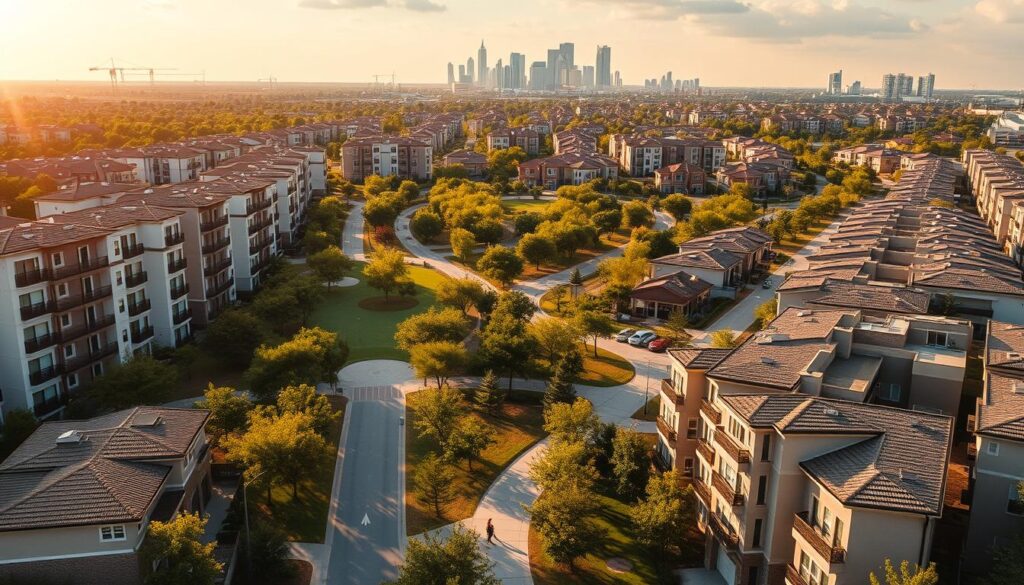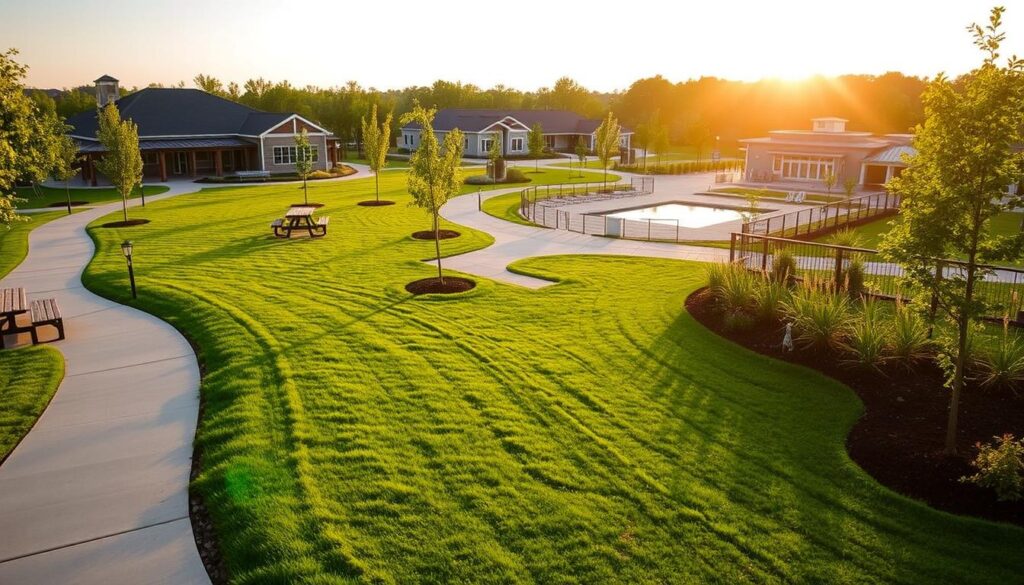Finding the right property in Houston, TX, requires careful planning. With numerous master-planned neighborhoods and builders, buyers need a clear strategy to evaluate options. This guide simplifies the process, offering actionable steps to identify communities that align with your lifestyle and budget.
Factors like amenities, location accessibility, and builder track records play critical roles. For example, some areas prioritize green spaces, while others focus on urban convenience. Partnering with experts like New Homes Houston Texas ensures access to localized insights—call (954) 821-4492 for tailored advice.
The Houston area caters to diverse preferences, whether you seek family-friendly environments or investment-ready properties. This resource combines market data with practical tips, making it ideal for first-time buyers and seasoned investors alike. Upcoming sections will break down each step, from researching builders to evaluating long-term value.
Key Takeaways
- Master-planned communities offer varied amenities tailored to different lifestyles.
- Builder reputation impacts construction quality and post-purchase support.
- Location affects commute times, school access, and property appreciation.
- Personalized guidance from local experts streamlines decision-making.
- Market trends in Houston influence pricing and availability timelines.
Exploring the Houston New Homes Landscape
Houston’s residential market thrives on diversity, blending urban convenience with suburban tranquility. Recent data shows a 12% annual increase in housing starts, driven by demand for modern layouts and energy-efficient designs. Over 60% of buyers prioritize access to parks and retail hubs, reshaping development priorities.

Overview of Houston Housing Trends
Neighborhoods like Katy and Sugar Land exemplify the shift toward integrated living. These areas combine high-performing schools with mixed-use zoning, attracting families and professionals. For instance, 8 of the top 15 Texas school districts reside within Houston’s metro area.
Role of Master-Planned Communities
Master-planned developments now account for 35% of new constructions. These spaces emphasize walkability and shared amenities. The table below highlights key features of popular options:
| Community | School Rating (Avg.) | Top Amenities |
|---|---|---|
| The Woodlands | 9.2/10 | Trails, lakes, shopping districts |
| Bridgeland | 8.9/10 | Community pools, sports complexes |
| Cross Creek Ranch | 8.7/10 | Fitness centers, event lawns |
Residents often cite proximity to parks and retail as deciding factors. Over 70% of buyers in these communities value having schools within a 10-minute drive. This alignment between infrastructure and lifestyle fuels long-term neighborhood appeal.
Effective Strategies: how to compare new home communities houston
Navigating Houston’s real estate options demands a structured approach. Buyers benefit from combining market insights with personal priorities to identify communities matching their goals. Start by gathering listings from reputable platforms and local agencies.

Step-by-Step Comparison Process
First, review median pricing trends from the past 12 months. Areas like Cypress and Spring saw 6-8% annual appreciation, while resale rates vary by builder. Next, create a checklist covering design flexibility, included upgrades, and payment plans.
Prioritize developments with multiple floorplans. This ensures adaptability for growing families or remote workspaces. Cross-reference sales velocity data—fast-selling neighborhoods often signal strong demand and future value retention.
Key Considerations for Homebuyers
Balance financial metrics with lifestyle needs. A community’s vibe becomes evident during weekend visits—observe parks, retail traffic, and resident interactions. Builder reputation matters: 78% of buyers report better experiences with companies offering 10-year structural warranties.
Partnering with agents provides access to off-market options and builder incentives. For example, some communities offer closing cost assistance or rate buy-downs during promotional periods. Always verify construction timelines to avoid move-in delays.
Evaluating Home Communities: Neighborhoods, Amenities, and More
A neighborhood’s surroundings shape daily experiences and property potential. Amenities and school quality often rank highest among buyer priorities, directly influencing resale value and lifestyle satisfaction.

Quality of Local Schools
Top-rated schools boost property values by an average of 7% compared to areas with average-rated institutions. Districts like Cypress-Fairbanks ISD and Katy ISD frequently appear on U.S. News & World Report’s annual rankings. Homes near these schools often sell 18 days faster than regional averages.
Recreational Facilities and Community Amenities
Modern developments increasingly feature sports pavilions and water parks alongside traditional pools. Walking trails and tennis courts promote active lifestyles while fostering neighbor interactions. Over 40% of buyers consider shared spaces like event lawns essential for social connections.
Weekly farmers’ markets or seasonal festivals further enhance neighborhood appeal. Visiting during these events lets you gauge engagement levels. Prioritize areas where amenities align with your family’s interests—whether that’s yoga studios or youth sports leagues.
Thoroughly assessing these elements helps identify locations offering both immediate comfort and lasting investment returns. Partnering with knowledgeable agents ensures access to verified data on school performance and facility maintenance standards.
Assessing Builders and Construction Quality in Houston
Builder reputation separates exceptional properties from mediocre ones. A 2023 Texas Real Estate Commission study found homes from certified builders retain 18% more value over five years than uncertified competitors. This gap highlights why vetting track records matters.
Key indicators distinguish top performers:
- 82% of buyers prioritize builders offering 10-year structural warranties
- Energy Star-certified firms report 23% fewer post-purchase repair requests
- Communities using impact-resistant windows see 15% lower insurance premiums
| Builder | Years Active | Avg. Customer Rating |
|---|---|---|
| Perry Homes | 55+ | 4.8/5 |
| David Weekley | 45+ | 4.7/5 |
| Lennar | 30+ | 4.5/5 |
Material choices directly impact durability. For example, fiber-cement siding lasts 50 years versus vinyl’s 20-year lifespan. Review spec sheets for moisture-resistant flooring or hurricane straps in coastal zones.
Sales data reveals patterns. Neighborhoods by Southern Living-featured builders sell 11 days faster than others. Cross-check Better Business Bureau profiles and third-party inspection reports to verify consistency.
Testimonials offer practical insights. One Spring-area buyer noted, “Our builder fixed drywall cracks within 48 hours—no extra charges.” Such responsiveness builds trust in long-term partnerships.
Understanding Community Lifestyle and Family Living
Family satisfaction often hinges on the environment where memories are made. Thoughtful community layouts and shared amenities create settings where relationships flourish. Local agents report that 68% of buyers prioritize neighborhoods offering both private retreats and social gathering spots.
Core Elements of Thriving Neighborhoods
Spacious floor plans rank among the top requests for growing households. Open-concept kitchens and flexible rooms accommodate evolving needs, from homework stations to hybrid work setups. Safe play zones with shaded equipment reduce parental stress while encouraging outdoor activity.
Parks and community centers act as social glue. Weekly movie nights or seasonal festivals foster connections across age groups. One resident shared, “Our kids learned to bike on the community trails while we met other parents—it’s where friendships began.”
- Dedicated picnic areas with built-in grills
- Walking paths linking homes to schools
- Pet-friendly zones with agility courses
Modern real estate trends emphasize multi-generational design. Features like zero-step entries and wider doorways accommodate aging relatives. Builders now integrate smart home tech into family spaces, from voice-controlled lighting to security cameras.
Balancing aesthetics with practicality ensures lasting appeal. Durable countertops and stain-resistant carpets withstand daily chaos while maintaining style. Agents suggest touring during weekends to witness community energy firsthand before committing.
Considering Location and Accessibility in Greater Houston
Daily routines and lifestyle quality often depend on where you plant roots. Strategic positioning near transit corridors and activity hubs can transform hectic schedules into manageable routines. Recent studies show neighborhoods with easy access to major highways reduce average commute time by 22% compared to isolated areas.

Commute Times and Proximity to Key Centers
Houston’s Energy Corridor and Medical Center employ over 300,000 workers combined. Properties within 15 miles of these zones save residents 45+ hours annually in drive time. The table below illustrates how three popular areas balance accessibility:
| Area | Avg. Commute (Minutes) | Key Employment Hubs Nearby |
|---|---|---|
| The Woodlands | 32 | ExxonMobil Campus, Hughes Landing |
| Katy | 28 | Houston Premium Outlets, Katy Mills |
| Sugar Land | 35 | Imperial Market, Fluor Corporation |
Recreational trails and greenbelts enhance daily living while boosting property appeal. Homes near Terry Hershey Park see 9% faster sales than those without nature access. One resident noted, “Walking paths let me decompress after work without driving anywhere.”
Mapping tools like Houston-Galveston Area Council’s traffic heatmaps help assess true accessibility. Agents recommend touring areas during rush hour to experience real-world conditions. Prioritizing easy access to essentials creates lasting convenience, whether you’re commuting or enjoying weekend adventures.
Financing and Budgeting for New Construction Homes in Houston
Smart financial planning unlocks doors to Houston’s latest residential opportunities. Begin by assessing your savings and credit score—most lenders require a minimum 620 FICO score for conventional loans. Energy-efficient features in modern builds can reduce utility bills by 15-30%, offering long-term savings alongside potential tax credits.
| Mortgage Type | Avg. Rate (2024) | Best For |
|---|---|---|
| FHA Loan | 6.25% | Low down payment (3.5%) |
| Conventional | 6.75% | Strong credit profiles |
| VA Loan | 6.10% | Military families |
Budgeting requires more than sticker price calculations. Factor in 1-3% of the purchase price for closing costs and 1.5% annually for maintenance. Local builders often provide incentives like appliance packages or rate buydowns—ask about these during negotiations.
Consider 5-year cost projections. Rising insurance premiums in flood-prone areas might offset energy savings. One Katy homeowner reported, “Our solar panels cut power bills by $180 monthly, but we added flood coverage.”
Partner with Houston-based mortgage specialists familiar with regional programs. Texas Department of Housing data shows first-time buyers save 8% on average using state-assisted loans. Schedule consultations early to explore customized solutions matching your timeline and risk tolerance.
Comparing Top Houston Neighborhoods and Master-Planned Communities
Smart buyers analyze market metrics alongside builder credibility to identify thriving areas. Recent sales patterns reveal distinct advantages across Houston’s residential zones, shaped by construction standards and community planning.
Data-Driven Neighborhood Comparisons
Median prices in premier areas range from $385,000 to $620,000, reflecting amenities and build quality. The table below contrasts three high-demand locations using 2024 data:
| Neighborhood | Median Price (2024) | Annual Appreciation | Top Builder |
|---|---|---|---|
| Memorial | $615,000 | 5.8% | Perry Homes |
| Cinco Ranch | $489,000 | 6.3% | Lennar |
| Pearland | $397,000 | 7.1% | David Weekley |
Areas with Energy Star-certified construction homes report 14% faster sales. Cinco Ranch’s 18-mile trail system contributed to its 22-day average listing period—15 days below regional norms.
Insights from Local Realty Experts
Seasoned agents emphasize builder reputation when evaluating communities. “Buyers pay premiums for neighborhoods backed by established home builders,” notes Sarah Elkins of Houston Urban Properties. “Their warranties reduce long-term risks.”
Case studies highlight this trend. A 2023 Pearland development by David Weekley sold 92% of units pre-construction. Buyers cited the company’s hurricane-resistant designs as a key factor. Similarly, Memorial’s custom floorplans attract professionals seeking luxury homes in Houston’s urban corridor.
Market analytics simplify decision-making. Cross-referencing school ratings with price-per-square-foot data uncovers hidden gems. Partnering with agents provides access to MLS trends and builder incentives rarely advertised publicly.
Navigational Tips for First-Time Home Buyers in Houston
Stepping into the housing market as a first-time buyer requires both enthusiasm and strategic planning. Local agents recommend starting with a customized roadmap that balances financial readiness with lifestyle priorities.
Preparing Your Investment Plan
Establishing clear financial boundaries prevents overextending budgets. Begin by calculating monthly expenses beyond mortgage payments—property taxes, insurance, and maintenance often add 25-30% to base costs. Explore buying options through lenders offering first-time incentives, like reduced down payments or closing cost assistance.
| Priority | Action Items | Resources |
|---|---|---|
| Budgeting | Review credit reports, calculate debt-to-income ratio | Houston Housing Authority tools |
| Neighborhood Research | Visit community centers, test commute routes | City planning department maps |
| Financing | Compare fixed vs. adjustable-rate loans | Local credit union seminars |
One agent advises, “Attend free workshops at libraries or recreation centers—they demystify loan processes and highlight city-specific programs.” Digital tools like the Texas Real Estate Commission’s affordability calculator help visualize long-term commitments.
Evaluate neighborhoods during different times. Morning visits reveal school traffic patterns, while evenings showcase community engagement. Many developments host weekend events—ideal opportunities to chat with residents about area pros and cons.
- Bookmark city websites for zoning updates
- Request builder warranty details in writing
- Schedule pre-approval meetings early
Seasoned buyers emphasize flexibility. As market conditions shift, having backup options ensures you capitalize on emerging opportunities without compromising core needs.
Conclusion
Selecting the ideal property involves balancing practical needs with future aspirations. Quality construction, strategic locations, and tailored amenities remain critical factors in securing lasting value. Over the years, data-driven analysis has proven essential for navigating shifts in the housing market while aligning purchases with personal priorities.
Professional guidance simplifies complex decisions. Experts like those at New Homes Houston Texas provide localized insights into builder reputations, neighborhood dynamics, and financing options. Their expertise helps buyers avoid common pitfalls, ensuring choices stand the test of time.
Current trends emphasize energy efficiency and community-centric designs—features that enhance daily living while boosting resale potential. Whether prioritizing top-rated schools or proximity to employment hubs, informed decisions directly impact lifestyle satisfaction and financial outcomes.
Ready to take the next step? Use this guide as your roadmap, then reach out at (954) 821-4492 for customized support. Your dream property awaits, backed by research and seasoned expertise.





